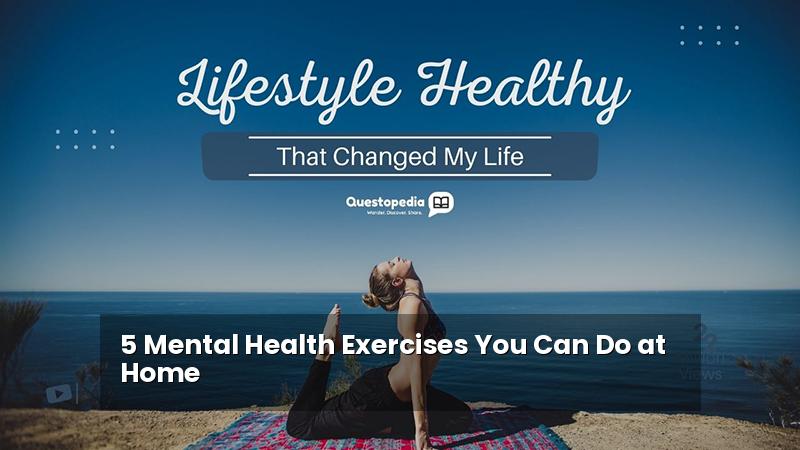5 Mental Health Exercises You Can Do at Home
In today’s fast-paced world, prioritizing our mental health is more crucial than ever. While seeking professional help is essential for some, many effective exercises can be easily integrated into your daily routine at home to boost your mood, reduce stress, and enhance your overall well-being. This article outlines five accessible and practical mental health exercises you can do right now from the comfort of your own space.
1. Mindful Meditation: Finding Calm in the Chaos
Mindful meditation involves focusing your attention on the present moment without judgment. This practice can significantly reduce stress, improve focus, and cultivate a sense of inner peace. You don’t need any special equipment – just a quiet space and a few minutes of your time.
How to do it:
- Find a comfortable position, either sitting or lying down.
- Close your eyes gently and focus on your breath.
- Notice the sensation of each inhale and exhale.
- When your mind wanders (and it will!), gently redirect your attention back to your breath.
- Start with 5-10 minutes and gradually increase the duration as you become more comfortable.
Numerous apps and online resources offer guided meditation sessions, perfect for beginners. Check out Headspace or Calm for guided meditations and tools to aid your practice.
2. Gratitude Journaling: Focusing on the Positive
Expressing gratitude is a powerful tool for improving mental well-being. Gratitude journaling involves regularly writing down things you are thankful for. This practice can shift your focus away from negative thoughts and cultivate a more positive outlook on life.
How to do it:
- Find a notebook or journal.
- Each day, write down 3-5 things you are grateful for. These can be big or small, tangible or intangible.
- Focus on the specific details of why you are grateful for each item.
- Take a few moments to reflect on the positive feelings associated with each item.
Regularly practicing gratitude journaling can lead to increased happiness, improved sleep, and a greater sense of connection to others.
3. Physical Activity: Moving Your Body, Boosting Your Mind
Physical activity is not just beneficial for your physical health; it’s also a powerful tool for improving your mental health. Exercise releases endorphins, which have mood-boosting effects. You don’t need to hit the gym – simple activities like walking, dancing, or yoga can make a significant difference.
How to do it:
- Aim for at least 30 minutes of moderate-intensity exercise most days of the week.
- Find an activity you enjoy and that fits into your lifestyle.
- Break up your exercise into smaller chunks if needed.
- Consider trying online fitness classes or following exercise videos.
Check out free workout videos on YouTube from channels like Yoga with Adriene for a variety of yoga and mindfulness practices.
4. Creative Expression: Unleashing Your Inner Artist
Engaging in creative activities can be a fantastic way to express your emotions, reduce stress, and boost your mood. Whether it’s painting, drawing, writing, playing music, or any other form of creative expression, allowing yourself to explore your creative side can be incredibly therapeutic.
How to do it:
- Choose a creative activity that interests you.
- Set aside some time each day or week to engage in your chosen activity.
- Don’t worry about being “good” at it – focus on the process of creating and expressing yourself.
- Experiment with different materials and techniques.
Remember, the goal is not to create a masterpiece, but to enjoy the process and tap into your inner creativity. Explore different creative activities and find what resonates with you. Learn more about the benefits of art therapy from the American Art Therapy Association.
5. Social Connection: Nurturing Relationships
Humans are social beings, and connecting with others is vital for our mental health. Spending time with loved ones, talking to friends, or joining a social group can provide a sense of belonging, reduce feelings of loneliness, and boost your overall well-being. Make it a point to connect with others regularly, even if it’s just a phone call or a video chat.
How to do it:
- Schedule regular time to spend with loved ones.
- Reach out to friends you haven’t spoken to in a while.
- Join a club or group that aligns with your interests.
- Volunteer your time to a cause you care about.
Maintaining strong social connections is a key component of a healthy and fulfilling life. Visit SAMHSA’s website to learn more about the importance of social connection for mental health.
Conclusion
Prioritizing your mental health is an ongoing journey, not a destination. By incorporating these five simple exercises into your daily routine, you can take proactive steps to manage stress, improve your mood, and enhance your overall well-being. Remember to be patient with yourself, celebrate your progress, and don’t hesitate to seek professional help if you need it. These exercises are a great starting point, but they are not a replacement for therapy if you are struggling with a mental health condition. Visit Questopedia for more articles on personal development and well-being.






